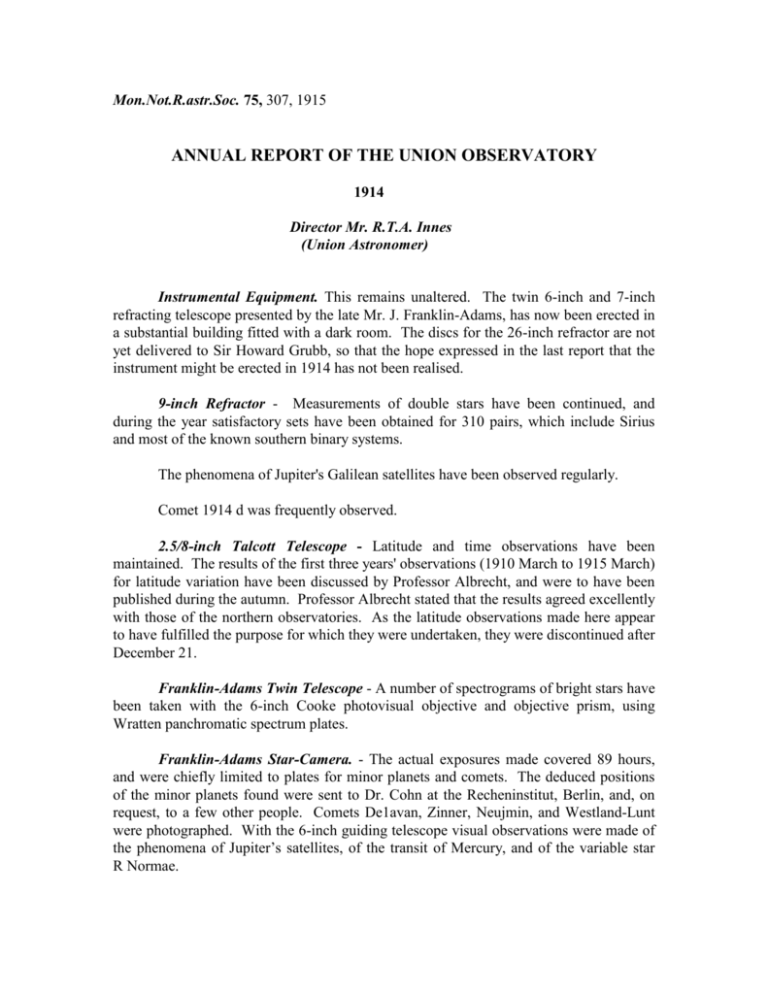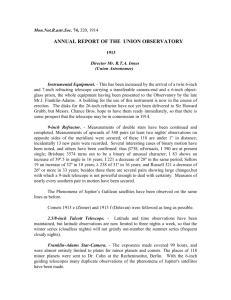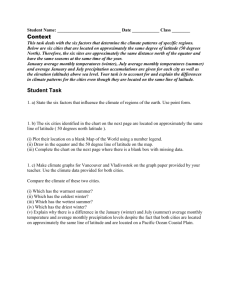1914
advertisement

Mon.Not.R.astr.Soc. 75, 307, 1915 ANNUAL REPORT OF THE UNION OBSERVATORY 1914 Director Mr. R.T.A. Innes (Union Astronomer) Instrumental Equipment. This remains unaltered. The twin 6-inch and 7-inch refracting telescope presented by the late Mr. J. Franklin-Adams, has now been erected in a substantial building fitted with a dark room. The discs for the 26-inch refractor are not yet delivered to Sir Howard Grubb, so that the hope expressed in the last report that the instrument might be erected in 1914 has not been realised. 9-inch Refractor - Measurements of double stars have been continued, and during the year satisfactory sets have been obtained for 310 pairs, which include Sirius and most of the known southern binary systems. The phenomena of Jupiter's Galilean satellites have been observed regularly. Comet 1914 d was frequently observed. 2.5/8-inch Talcott Telescope - Latitude and time observations have been maintained. The results of the first three years' observations (1910 March to 1915 March) for latitude variation have been discussed by Professor Albrecht, and were to have been published during the autumn. Professor Albrecht stated that the results agreed excellently with those of the northern observatories. As the latitude observations made here appear to have fulfilled the purpose for which they were undertaken, they were discontinued after December 21. Franklin-Adams Twin Telescope - A number of spectrograms of bright stars have been taken with the 6-inch Cooke photovisual objective and objective prism, using Wratten panchromatic spectrum plates. Franklin-Adams Star-Camera. - The actual exposures made covered 89 hours, and were chiefly limited to plates for minor planets and comets. The deduced positions of the minor planets found were sent to Dr. Cohn at the Recheninstitut, Berlin, and, on request, to a few other people. Comets De1avan, Zinner, Neujmin, and Westland-Lunt were photographed. With the 6-inch guiding telescope visual observations were made of the phenomena of Jupiter’s satellites, of the transit of Mercury, and of the variable star R Normae. Observatory Circulars. Nos. 10 to 21 were distributed in 1914, and No. 22 is in the Government Printer's hands. The chief contents of these circulars are:- No. 10, Third series of double-star measures; No.11, Places of Comet 1913e, Zinner, and inviting attention to the advisability of adopting astrographic places for comets and planets so as to bring visual practice into conformity with photographic practice; No. 13, Phenomena of Jupiter's satellites; No. 14, Places of Comet l9l3f, Delavan; No.15, Difference of longitude Johannesburg and Lourenco Marques; No.16, A reference list of photographs obtained with the FranklinAdams star-camera; No.17, List of earthquakes registered since 1910 July; No. 18, Region around η Argûs; No. 19, A list of proper motion stars south of -19º Dec; No.20, Upon the use of the stereo-comparator and blink-microscope in examining celestial photographs, and upon the measure of time; No. 21, The transit of Mercury, which was well observed in all its phases; No.22, Places of Comet 1914 d, Westland-Lunt. Time-Service, Meteorological and Seismological Observations. These have continued unchanged. The time-ball at the Bluff, Durban, is dropped by a direct current from the Observatory at noon. A second sidereal clock, Riefler No. 304, has been installed. Staff. Mr. Innes, and early in the year Mr. van der Spuy measured double stars with the 9-inch telescope, but Mr. van der Spuy left to join the Aviation Corps of the Defence Force, and later volunteered for service on the Continent, where he now is. He was succeeded by Mr. E.L. Johnson. Mr. Wood is in charge of the Franklin-Adams starcamera, and Mr. Worssel in charge of the latitude and time observations and the twin telescope. Mr. Simpkins, until he left, and after him Mr. Johnson, assisted Mr. Worssel with the time and latitude observations. Mr. Innes and Mr. Wood took part in the observations of the phenomena of Jupiter's satellites.






